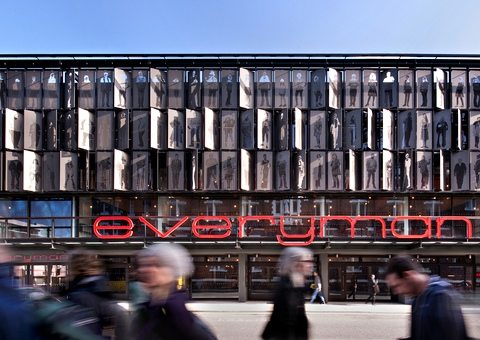A soaring glass shaft goes head to head with a swooping grey stingray in the race for the best building of the year, as the Shard squares up against London's Olympic swimming pool. These bombastic signature buildings, by Pritzker prize-winning architects Renzo Piano and Zaha Hadid, are in the running against Birmingham's vast new public library, a theatre in Liverpool and two higher education buildings, in a shortlist that sees the return of familiar names from previous years' Stirling prize contenders.
With odds of 2-1, the £500m Shard is the bookies' favourite, but the tallest building in the EU has divided critics and public alike. It has garnered acclaim for its unique faceted form, with Will Self describing its jagged presence on the skyline being "as exhilarating as Niagara". Others see it as a monument to a city in thrall to international capital and an unwelcome intrusion: Simon Jenkins argues that it has "slashed the face of London forever".
Zaha Hadid's £269m Aquatics Centre in east London's Olympic Park, the second-favourite at 5-2, has had an equally bumpy ride. Conceived as the glory of the games, its sinuous style was cramped by being jammed between two huge seating stands during the Olympics, making it look like someone forgot to remove the scaffolding. While its streamlined interior wowed TV viewers, the undulating roof form came in for criticism over its prodigious use of steel, given the lean, stripped-back structures of other venues around the park.
Hadid has won the Stirling prize twice before – for the billowing concrete of the Maxxi art centre in Rome in 2010 and the Evelyn Grace Academy school in Brixton, which narrowly beat the Olympic velodrome to the gong in 2011.
She is joined this year by previous Stirling winners Feilden Clegg Bradley, whose understated extension to Manchester School of Art is a surprising but welcome inclusion on the shortlist, standing for the imaginative potential of refurbishing, rather than bulldozing, our cities' postwar concrete structures.
Birmingham's 1970s brutalist Central Library is one such megastructure that faces the wrecking ball now that the £190m new library is open, a sparkling cruise-liner of a building by Dutch practice Mecanoo, who, like Piano, feature on the shortlist this year for the first time. Its loud costume and glistening interiors stand in contrast to Haworth Tompkins's Everyman Theatre in Liverpool, which summons the informal spirit of the previous theatre on the site, crafting interiors of a rare tactile quality.
Such attention to the craftsmanship of building reaches its peak with O'Donnell and Tuomey's new student centre for the London School of Economics, a handmade brick mountain that contains a beguiling sequence of interior spaces within its origami folds. Shortlisted for the prize on four separate occasions since 1999, could this finally be the year for the Dublin-based duo to triumph?
Architects can choose when they enter their creations for the Stirling prize. Most wait until they are completely finished. The Aquatics Centre still had temporary seating structures for the Olympics, which have now been removed. The Shard's hotel was only completed this year despite having been operational for more than a year. A panel of judges whittled the long list of 56 entries down to the six that were announced on Thursday.
The finalists
The Shard by Renzo Piano Building Workshop (odds: 2-1)
As celebrated as it is reviled, the Shard is a divisive presence on the London skyline. The tallest building in the EU at 306 metres, it is a beacon of confidence to some; to others, it is a mostly-empty monument to Mammon and a totem of Qatari investment. Thrusting above London Bridge station as a crystalline spear, its faceted facade of fractured glass planes gives it a constantly changing appearance, oscillating between glowering grey hulk and shimmering apparition.
The work of Italian architect Renzo Piano, it is conceived as a "vertical village" of offices and restaurants, a hotel and apartments – although, with separate entrances and no communal space, it is more an exclusive silo of separate private worlds. A thing of elegance and beauty on the skyline, the building stutters and stumbles where it hits the ground, with a cacophony of clumsy canopies and a dumb frontage to the street.
London Aquatics Centre by Zaha Hadid Architects (odds: 5-2)
Hailed as the beauty queen of London's Olympic Park, Hadid's aquatics centre ripples into view like a lithe stingray, flexing its muscular fins on the banks of the River Lea. Inside, it is like swimming beneath the belly of a whale, the roof writhing and dipping above your head in a broad ribbed bulge, before landing on a curvaceous concrete plinth that feels carved out of the bedrock. It is a singular, compelling universe within, but – like many of Hadid's projects – it has difficulty where it meets the real world outside. Rather than floating free, it seems awkwardly parked on a grassy berm, while the main entrance is more like a service hatch, tucked away down the back stairs. At a cost of £269m, it uses 3,000 tonnes of steel to achieve its gymnastic feat, compared to the 100 tonnes of the lean velodrome – a model project that lost out on the Stirling prize in 2011 to Hadid's bombastic Evelyn Grace school in Brixton.
London School of Economics' Saw Swee Hock Student Centre by O'Donnell & Tuomey Architects (odds: 4-1)
A twisting, tumbling mountain of bricks, the LSE's new student centre rises out of the knotted tangle of streets behind Aldwych as a striking red cliff-face. Limboing beneath its neighbours' rights to light, the contorted envelope houses a winding promenade of diverse functions, from cafes and workspaces to the student radio station and a gym. A generous staircase charts a wayward journey of spirals and switchbacks, like a great concrete helter-skelter that corkscrews through the building, with internal windows positioned to give glimpses of the numerous activities going on at any time. Its pace is slowed by kinks and eddies, spilling out into nooks and crannies to pause and chat. As with most of O'Donnell & Tuomey's projects, it is built with rare attention to detail, using handmade bricks and cast terrazzo, sawn oak and vitreous enamel, contrasting things that are roughly cast and smoothly polished, forming a dazzling essay in the craft of making.
Library of Birmingham by Mecanoo (odds: 5-1)
Towering above Birmingham's Centenary Square as a great pile of boxes wrapped in a filigree metal screen, the £190m new central library is an optimistic beacon at a time when swingeing national cuts have seen widespread library closures. The work of Dutch practice Mecanoo, purveyors of daring forms in jazzy materials, it continues Birmingham's recent vernacular of big sheds covered in sparkly wrapping (following Future Systems' Selfridges and Make's Cube) as a nod to the city's jewellery trade. The building houses a spectacular sequence of spaces, where escalators shuttle visitors upwards through interlocking atria and stately book rotundas, which appear to hover between light-flooded reading floors. The stepped form of the building also creates expansive roof gardens where readers can enjoy grandstand views across the city. It is a generous, much-loved facility, but the architecture can sometimes feel a little too brash airport-mall than place of knowledge and learning.
Everyman Theatre, Liverpool by Haworth Tompkins (odds: 6-1)
Already accomplished masters of theatre refurbishment, this is the first newbuild theatre by Haworth Tompkins, who have previously worked their magic on the Royal Court, Young Vic and the Egg in Bath. Replacing a converted Victorian chapel, where Roger McGough and Willy Russell started out in the 1960s, the building summons the spirit of the much-loved former venue, recreating its 10m x 10m thrust stage and using robust materials designed to improve with the patina of time. It is a tactile assemblage of raw concrete and gnarled brickwork, cork and stained plywood, copper light-fittings and glazed tiles. It answers a brief that it "shouldn't feel too posh" with a welcoming series of foyer spaces, winding from the street to the auditorium in a theatrical sequence, and a lively facade clad with tilting aluminium shutters that feature over a hundred portraits of local residents. It does that rare and precious thing for a new building of feeling like it has always been there.
Manchester School of Art by Feilden Clegg Bradley Studios (odds: 9-1)
Perhaps the least glamorous project of the bunch, the refurbishment and extension of Manchester School of Art is one of the most important on the list. As unloved 1960s buildings continue to be needlessly demolished (including Birmingham's former Central Library), it provides an object lesson in how they can instead be revived with thoughtful intervention. Adding a seven-storey block next to an existing 1960s arts tower, it creates an airy "design shed" of open studios, designed to encourage cross-fertilisation between departments. Flying staircases and bridges zig-zag through the space, adding an industrial, factory-floor feel. Employing a workmanlike palette of industrial materials, offset with ornamental details – including concrete columns imprinted with a Lewis Day wallpaper pattern – the building provides a robust new home for the students' creativity at a time when many other art schools are struggling for space and forcing students to work in their bedrooms.











